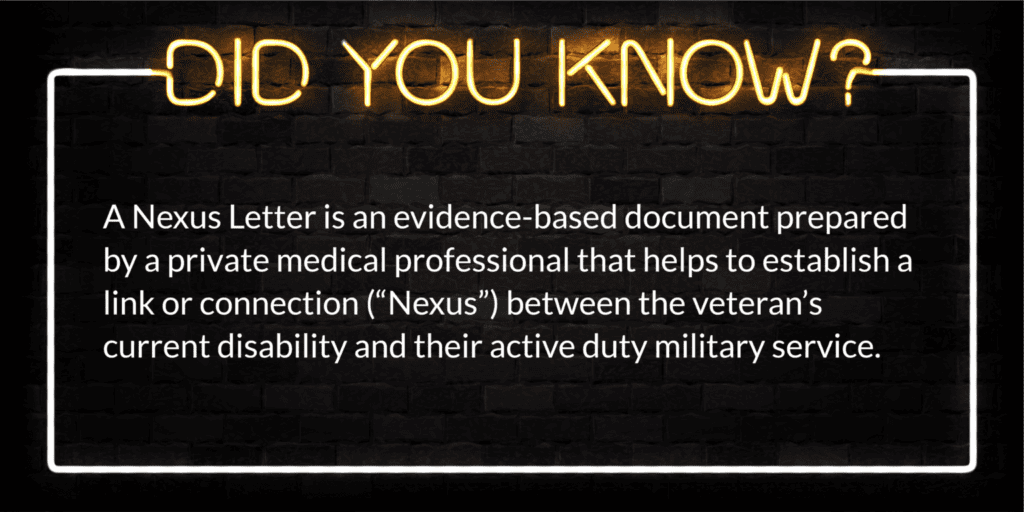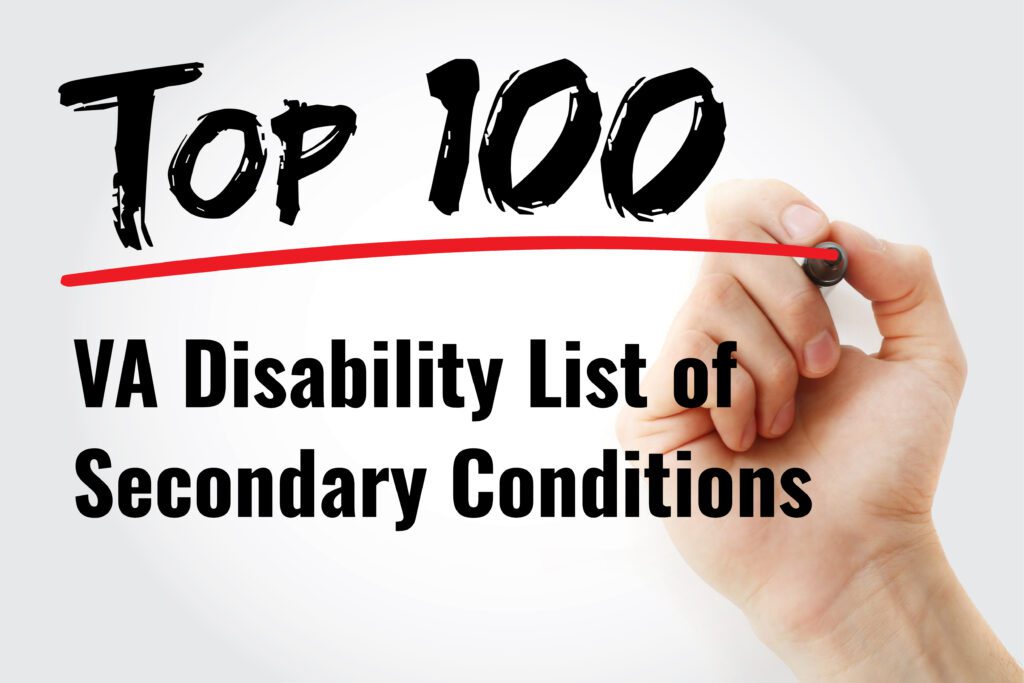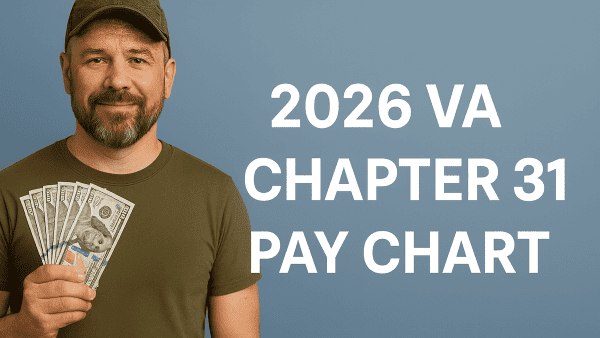Looking for Expert-Level VA Claim Answers?📱Call Us Now! 737-295-2226
Hi Fellow Veterans, Brian Reese here with VA Claims Insider, and in this Ultimate Guide, I’m going to reveal and explain the Top 100+ VA Disability List of Secondary Conditions for 2025.
Although this list is not exhaustive, we tried to stick with the most common VA secondary claims for secondary service connection.
You’ll also discover the key requirements for establishing secondary service connection to qualify for VA disability benefits.
But first, let’s explore the five (5) types of service connection, keeping in mind the focus of this post, which is secondary service connection and secondary service connection via aggravation.
Let’s begin!
Table of Contents
5 Types of VA Service Connection for Service Connected Disability Benefits

#1. Direct Service Connection
This is the most common method of service connection for VA disability compensation benefits. You’re telling the VA that your current disability condition is the direct result of your active duty military service.
Maybe it was a training incident, car accident, combat deployment, stress from the job, or other in-service incident, injury, event, or disease that directly caused or made your current disability condition worse. An example is combat PTSD due to constant rocket and mortar attacks in Afghanistan. The PTSD is due to your combat deployment, which is directly related to your military service.
#2. Secondary Service Connection
In accordance with 38 CFR § 3.310 current disability condition that is proximately due to or the result of a service-connected disease or injury shall also be service connected. Let’s say, for example, you contracted tinnitus while serving. Today, even though you are no longer serving, that service-connected tinnitus might be causing migraine headaches, anxiety, and/or depression.
Service connection on a secondary basis requires a “showing of causation.” Instead of proving that your disability is directly service-connected, you’ll need to prove that it’s caused or made worse by a different disability (which is service-connected). In this example, you could file a VA disability claim for migraine headaches secondary to your service-connected tinnitus. Secondary Service Connection and related conditions that can be secondary VA claims are the primary focus of this eBook!
Pro Tip: A Nexus Letter is highly recommended for secondary VA claims to help you prove a secondary service connection under the law. >> Click HERE NOW << to sign up for our premier education-based Coaching/Consulting program VA Claims Insider Elite, start right now, connect with a Veteran Coach in minutes, and potentially get high-quality Nexus Letters at members-only rates (if wanted and warranted by the evidence of record).
#3. Presumptive Service Connection
If your disability condition meets certain criteria (set forth by Congress), then your disability condition will be presumed to have been caused by service. Examples include certain chronic debilitating diseases, diseases specific to radiation exposure, diseases associated with herbicide agents (to include Blue Water Veterans), Persian Gulf War Veterans, and Camp Lejeune Veterans. (38 CFR § 3.309 discusses diseases subject to presumptive service-connection in more detail.)
Pro Tip: While you are not required to provide a “Nexus” to establish presumptive service connection, it’s highly recommended that you at least write a personal statement as to WHY you think your disability meets the legal requirements for presumptive service connection. You might want to obtain a medical nexus letter as well.
#4. Service Connection by Aggravation
Sometimes a pre-existing condition is worsened by military service. For example, a veteran may have had flat feet prior to entering service but wearing military boots and prolonged standing worsened his or her flat feet leading to a painful disability called plantar fasciitis, which is eligible for compensation under the law.
Additionally, if a veteran has a service-connected knee condition that aggravates a non-service-connected back condition, they could get service connection for their back based on aggravation—provided they can prove that their condition was worsened beyond its natural progression by military service.
#5. Service Connection by 38 U.S.C 1151
This refers to disabilities or death that result from “hospital care, medical or surgical treatment, or examination” by a VA medical professional or facility, or due to participation in a program of vocational rehabilitation. In my experience, this type of service connection is uncommon.
What is VA Secondary Service Connection?

In accordance with 38 CFR § 3.310 disabilities that are proximately due to, or aggravated by, service-connected disease or injury, a current disability condition, which is proximately due to or the result of a service-connected disease or injury shall be service connected.
Service connection on a secondary basis requires a “showing of causation.”
A showing of causation requires that the secondary VA disability claim is “proximately due to” or “aggravated by” another service-connected disability.
There are three key elements that must be satisfied to prove VA secondary service connection under the law:
- A medical diagnosis of the secondary VA disability you’re attempting to link to the current service connected disability (must be documented in a medical record) AND
- A current service-connected primary disability (e.g., your current list of service connected disabilities from your VA.gov account) AND
- Medical nexus evidence establishing a connection between the service-connected primary condition AND the current disability you’re trying to connect secondary (e.g., Migraines, Sleep Apnea, GERD, IBS, Erectile Disfunction / Female Sexual Arousal Disorder, Radiculopathy, etc.)
The FIRST part can be satisfied with any existing medical evidence in service treatment records, VA medical records, or any private medical records.
The SECOND part can be satisfied with a veteran’s existing service-connected disability rated at 0% or higher.
The THIRD part, and often the missing link needed to establish secondary service connection, can be satisfied with a credible Medical Nexus Letter (Independent Medical Opinion) from a qualified medical provider.

>> Click HERE to Learn How to Find Doctors Who Write Nexus Letters (6-Step Tutorial)
Did you know there are HUNDREDS of common secondary VA claims that you can get service connected by law?
But here’s the brutal truth…
You could be missing out on thousands of dollars of tax-free disability compensation you deserve by law, and not even realize that your current VA disability might be caused or aggravated by an existing service connected disability.
Pro Tip: A Nexus Letter is HIGHLY RECOMMENDED to help establish secondary service connection.
Why?
Because “Medical Nexus Evidence” is needed to satisfy the third evidentiary element that must be satisfied to prove your secondary VA claim on an “at least as likely as not” basis.
Can VA Secondary Conditions Be Service Connected?

Yes, secondary conditions qualify for service connection, and include any of the 900+ VA disability list of secondary conditions in CFR Title 38, Part 4, the Schedule for Rating Disabilities that can be service connected SECONDARY to a current VA disability you’re already rated for at 0% or higher.
For example, let’s say you’ve got Tinnitus service-connected at 10%, but because of the severity of your Tinnitus, you’ve developed Migraine Headaches.
You can open new secondary VA claims on the VA.gov website. For example, you can file a claim for Migraines Secondary to Tinnitus and get service-connected and rated at 0%, 10%, 30%, or 50% for your Migraine (Headaches), depending on the Frequency, Severity, and Duration of your symptoms as well as how your symptoms negatively affect your work, life, and/or social functioning.
100+ Most Common VA Disability List of Secondary Conditions

- Anxiety secondary to Tinnitus
- Asthma secondary to GERD (acid reflux or heartburn)
- Asthma secondary to Obstructive Sleep Apnea
- Asthma secondary to Depression
- Asthma secondary to Anxiety
- Asthma secondary to Allergies
- Asthma secondary to Nasal polyps
- Asthma secondary to Vocal Cord Dysfunction (Inducible Laryngeal Obstruction)
- Asthma secondary to Asthma-COPD overlap syndrome
- Asthma secondary to Bronchiectasis
- Asthma secondary to Diabetes
- Bruxism secondary to PTSD
- Bruxism secondary to Depression
- Bruxism secondary to Anxiety
- Bruxism secondary to Tinnitus
- Depression secondary to Tinnitus
- Depression secondary to Migraines
- ED secondary to PTSD
- ED secondary to Depression
- ED secondary to Anxiety
- ED secondary to Medication Side Effects
- ED secondary to Heart Disease
- ED secondary to Atherosclerosis
- ED secondary to High Cholesterol
- ED secondary to Hypertension
- ED secondary to Diabetes
- ED secondary to Weight Gain Obesity as Interim Link
- ED secondary to Parkinson’s Disease
- ED secondary to Multiple Sclerosis
- ED secondary to Prostate Cancer
- ED secondary to Spinal Cord Injuries
- Female Sexual Arousal Disorder secondary to PTSD
- Female Sexual Arousal Disorder secondary to Depression
- Female Sexual Arousal Disorder secondary to Anxiety
- Female Sexual Arousal Disorder secondary to Heart Disease
- Female Sexual Arousal Disorder secondary to Neurological Conditions
- Female Sexual Arousal Disorder secondary to Gynecological conditions, such as Vulvovaginal Atrophy, Infections or Lichen Sclerosis
- Female Sexual Arousal Disorder secondary to Medication Side Effects
- Fibromyalgia secondary to IBS
- Fibromyalgia secondary to Migraines
- Fibromyalgia secondary to Interstitial Cystitis or Painful Bladder Syndrome
- Fibromyalgia secondary to Temporomandibular Joint Disorders
- Fibromyalgia secondary to Anxiety
- Fibromyalgia secondary to Depression
- Fibromyalgia secondary to Postural Tachycardia Syndrome
- GERD secondary to Asthma
- GERD secondary to PTSD
- GERD secondary to Depression
- GERD secondary to Anxiety
- GERD secondary to Medication Side Effects
- GERD secondary to Weight Gain Obesity as Interim Link
- Hypertension secondary to Sleep Apnea
- Hypertension secondary to PTSD
- Hypertension secondary to Weight Gain Obesity as Interim Link
- Hypertension secondary to Kidney Disease
- Hypertension secondary to Diabetes
- Hypertension secondary to Hyperthyroidism
- Hypertension secondary to Lupus
- Hypertension secondary to Scleroderma
- IBS secondary to PTSD
- IBS secondary to Depression
- IBS secondary to Anxiety
- IBS secondary to Medication Side Effects
- IBS secondary to Weight Gain Obesity as Interim Link
- Meniere’s Syndrome secondary to Tinnitus
- Meniere’s Syndrome secondary to Hearing Loss
- Meniere’s Syndrome secondary to Migraines
- Meniere’s Syndrome secondary to TBI
- Migraines secondary to Tinnitus
- Migraines secondary to Cervical Strain
- Migraines secondary to GERD
- Migraines secondary to IBS
- Migraines secondary to PTSD
- Migraines secondary to Insomnia
- Migraines secondary to Depression
- Migraines secondary to Anxiety
- Migraines secondary to TBI
- Migraines secondary to Medication Side Effects
- Migraines secondary to Meniere’s Disease
- Migraines secondary to Fibromyalgia
- Migraines secondary to Heart Disease
- Migraines secondary to Asthma
- Plantar Fasciitis secondary to Foot Condition
- Plantar Fasciitis secondary to Back Condition
- Plantar Fasciitis secondary to Knees, Hips, Joint Instability
- Plantar Fasciitis secondary to Weight Gain Obesity as Interim Link
- Radiculopathy secondary to Back Pain
- Radiculopathy secondary to Lumbosacral or Cervical Strain
- Radiculopathy secondary to Spinal Stenosis
- Radiculopathy secondary to Spondylolisthesis
- Radiculopathy secondary to Ankylosing Spondylitis
- Radiculopathy secondary to Spinal Fusion
- Radiculopathy secondary to Vertebral Fracture or Dislocation
- Restless Leg Syndrome secondary to Back Condition
- Restless Leg Syndrome secondary to Neck Condition
- Restless Leg Syndrome secondary to Medication Side Effects
- Restless Leg Syndrome secondary to Peripheral Neuropathy
- Sleep Apnea secondary to PTSD
- Sleep Apnea secondary to Sinusitis
- Sleep Apnea secondary to Rhinitis
- Sleep Apnea secondary to Deviated Septum
- Sleep Apnea secondary to Asthma
- Sleep Apnea secondary to Weight Gain Obesity as Interim Link
- Sleep Apnea secondary to GERD
- Somatic Symptom Disorder secondary to Tinnitus
- Somatic Symptom Disorder secondary to Back Condition
- Somatic Symptom Disorder secondary to Neck Condition
- Vertigo secondary to Tinnitus
- Vertigo secondary to Migraines
- Vertigo secondary to Medication Side Effects
- Vertigo secondary to Head or Neck Conditions
- Vertigo secondary to TBI
Need a Nexus Letter for Your Secondary VA Claim?
Trying to get a high-quality Nexus Letter to help service-connect your secondary VA disability claim?
WE GOT YOUR SIX!
Veterans who become members of the VA Claims Insider Elite program can get access to our preferred provider network who can potentially write VA Nexus Letters at members-only rates.
Why pay $1,500 to $2,000 for a Nexus Letter when you can get one for 60-70% OFF through VACI’s preferred provider network?
Click HERE to book a date and time to speak with a VA claim expert (no-obligation, no high-pressure sales tactics) or call us right now at: 737-295-2226.
Want Expert-Level VA Claim Help? WE GOT YOUR SIX!

- VA Claims Insider is the #1 most trusted name in VA disability claims.
- Work directly with a VA claims coach who can help lead you to VA claim victory.
- 25,000+ disabled veterans served in our membership programs since 2016.
- 30% average rating increase for veterans who complete our #1 rated Elite program.
- 4.7/5.0 average rating out of 5,500+ total reviews; over 4,500 5-star reviews.
About the Author

Brian Reese
Brian Reese is a world-renowned VA disability benefits expert and the #1 bestselling author of VA Claim Secrets and You Deserve It. Motivated by his own frustration with the VA claim process, Brian founded VA Claims Insider to help disabled veterans secure their VA disability compensation faster, regardless of their past struggles with the VA. Since 2013, he has positively impacted the lives of over 10 million military, veterans, and their families.
A former active-duty Air Force officer, Brian has extensive experience leading diverse teams in challenging international environments, including a combat tour in Afghanistan in 2011 supporting Operation ENDURING FREEDOM.
Brian is a Distinguished Graduate of Management from the United States Air Force Academy and earned his MBA from Oklahoma State University’s Spears School of Business, where he was a National Honor Scholar, ranking in the top 1% of his class.



